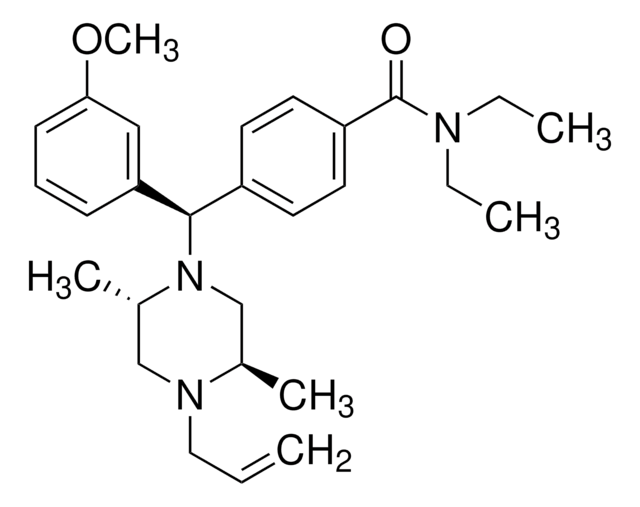G0544
GR 103691
≥98% (HPLC), solid
Synonym(e):
4′-Acetyl-N-[4-[4-(2-methoxyphenyl)-1-piperazinyl]butyl]-[1,1′-biphenyl]-4-carboxamide
About This Item
Empfohlene Produkte
Assay
≥98% (HPLC)
Form
solid
Farbe
white
Löslichkeit
DMSO: soluble >5 mg/mL at 60 °C
Ersteller
GlaxoSmithKline
Lagertemp.
2-8°C
SMILES String
COc1ccccc1N2CCN(CCCCNC(=O)c3ccc(cc3)-c4ccc(cc4)C(C)=O)CC2
InChI
1S/C30H35N3O3/c1-23(34)24-9-11-25(12-10-24)26-13-15-27(16-14-26)30(35)31-17-5-6-18-32-19-21-33(22-20-32)28-7-3-4-8-29(28)36-2/h3-4,7-16H,5-6,17-22H2,1-2H3,(H,31,35)
InChIKey
JARNORYOPMINDY-UHFFFAOYSA-N
Angaben zum Gen
rat ... Htr1a(24473)
Anwendung
- inducing effect on prepulse inhibition (PPI)
- suppressive effect of motor behavior in rats
- inhibitory effect on chemotaxis in newly excysted juvenile C. sinensis (CsNEJs)
Biochem./physiol. Wirkung
Leistungsmerkmale und Vorteile
Rechtliche Hinweise
Lagerklassenschlüssel
11 - Combustible Solids
WGK
WGK 3
Flammpunkt (°F)
Not applicable
Flammpunkt (°C)
Not applicable
Persönliche Schutzausrüstung
Eyeshields, Gloves, type N95 (US)
Analysenzertifikate (COA)
Suchen Sie nach Analysenzertifikate (COA), indem Sie die Lot-/Chargennummer des Produkts eingeben. Lot- und Chargennummern sind auf dem Produktetikett hinter den Wörtern ‘Lot’ oder ‘Batch’ (Lot oder Charge) zu finden.
Besitzen Sie dieses Produkt bereits?
In der Dokumentenbibliothek finden Sie die Dokumentation zu den Produkten, die Sie kürzlich erworben haben.
Unser Team von Wissenschaftlern verfügt über Erfahrung in allen Forschungsbereichen einschließlich Life Science, Materialwissenschaften, chemischer Synthese, Chromatographie, Analytik und vielen mehr..
Setzen Sie sich mit dem technischen Dienst in Verbindung.








